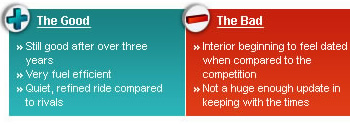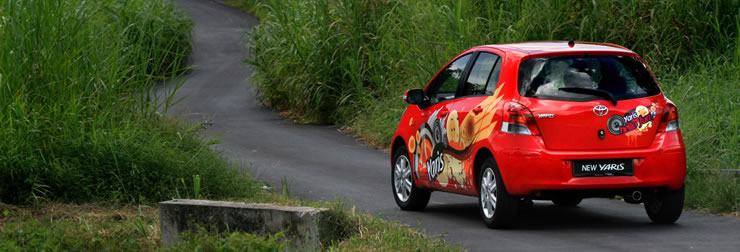Toyota Yaris 1.5 E (A) Facelift Review
29 Jun 2009|20,659 views
 |
That black grille housed between vertically descending lines gives cue to a new "voluminous headlamp design" that Toyota claims, has been adopted to create a stylish-looking appearance. To be honest, we can't tell the difference, but we don't care - the Yaris has always looked good in our books.
Turn your attention to the side mirrors though, and you'll spot the differences between the new and older one, where it comes integrated with turn signals, while the rear tail lamp cluster has been slightly changed. Apparently, amber signal covers have made a comeback since the early nineties.
The pair flanks a boot-lid that leads to a boot housing a full-sized spare tyre, believe it or not. The Yaris retains its "easy-flat" folding system where the interior geometry has been figured out in such a way that the one-piece backrests fold themselves down with just one lever-lifting action.
The head and seat cushions do not have to be toyed with. Even your front seats can be left in their rearmost positions when operating the device. Unfortunately, this has resulted a reduction in cargo loading volume - less than gaining rivals such as the new Honda Jazz/Fit, possibly the Nissan Latio.
On the inside, a new interior fabric material finds itself wrapped around everywhere, and is less dreary in appearance. In fact, we find it to be a little sporty too.
There are two variants in the present Yaris line-up. The basic LX model exists in order to make life difficult for the competitive Hyundai Getz model line-up as it's cheaper and more accessible to those who want to buy Thai, er, Japanese. It comes with a tilt-adjustable steering wheel, gated automatic shift lever, intermittent wipers with mist control, two sun visors, vanity mirrors and three well-sized cup-holders (see pictures).
 |
The next one up, a "Lifestyle" variant, arrives with matching leather seats, full-functioning fog lamps, various trim upgrades like a sports gear knob, sports pedals and side visors, expensive 3M Crystalline Solar Film and even a matching Ipod Nano. How's that for catering to the young and hip?
But the young and hip are rather particular people, and in being so they'll notice the barren door panels devoid of any sort of arm rests. Even the automatic window operating switch looks like an afterthought, sadly. But this was an expense of (still) class leading amounts of head, shoulder and leg room. It's about the same as what you might find in a Toyota Vios, and definitely more than in the outgoing Honda Jazz.
Performance
The ever-so-reliable 106-horsepower, 1.5-liter 1NZ-FE four-cylinder hasn't been changed either, and we don't see that as a bad thing. The same engine can be found in the Toyota Rush-G, Allion and Vios, all of which return extraordinary mileage figures even when driven rather briskly through town.
The "Shift Logic" system that Toyota claims helps reduce unnecessary shifting during uphill and downhill driving situations though, wasn't that much of a performer. It didn't make much of a difference regardless of terrain steepness, and took quite a while to respond before downshifting, much less holding the gears.
But the engine-gearbox combination worked quite well as a whole. First gear was extremely peppy, but while we had no problem overtaking slower moving vehicles, the engine quickly runs out of steam past 110 km/h in fourth.
What the Yaris does excel in though, is the fun-to-drive factor. A rigid L-arm MacPherson strut front design and hydro-formed rear torsion beam provides adequate anti-roll stabilization, eliminating the need for a separate anti-roll bar. Combined with a tight, springy steering and good suspension geometry, it was a joy through any tight sequence of corners in true hatch style.
The electrically-assisted power steering was devoid of feedback, which again emphasises my point on today's cars having excellent handling capabilities but poor steering communication - all done in the name of comfort, perhaps.
On standard 185/60 profile 15 inch rims and wet weather Bridgestones, the Yaris was surprisingly quiet, save for some road noise at highway cruising speeds.
Would you buy one?
In our last Yaris drive/article in Thailand, we stated that the Yaris might be left a little wanting in the department of space and overall finish, expecting a better improvement down the road. But with this minor mid-life facelift, not much has changed to be honest. The chief concern would be the interior of the Toyota. It pales in comparison to the abovementioned rivals, and much improvement is needed here.
However, as an econo-hatch, it puts up a really good fight in the performance and fuel economy department, and that's still something to look forward to.
 |
That black grille housed between vertically descending lines gives cue to a new "voluminous headlamp design" that Toyota claims, has been adopted to create a stylish-looking appearance. To be honest, we can't tell the difference, but we don't care - the Yaris has always looked good in our books.
Turn your attention to the side mirrors though, and you'll spot the differences between the new and older one, where it comes integrated with turn signals, while the rear tail lamp cluster has been slightly changed. Apparently, amber signal covers have made a comeback since the early nineties.
The pair flanks a boot-lid that leads to a boot housing a full-sized spare tyre, believe it or not. The Yaris retains its "easy-flat" folding system where the interior geometry has been figured out in such a way that the one-piece backrests fold themselves down with just one lever-lifting action.
The head and seat cushions do not have to be toyed with. Even your front seats can be left in their rearmost positions when operating the device. Unfortunately, this has resulted a reduction in cargo loading volume - less than gaining rivals such as the new Honda Jazz/Fit, possibly the Nissan Latio.
On the inside, a new interior fabric material finds itself wrapped around everywhere, and is less dreary in appearance. In fact, we find it to be a little sporty too.
There are two variants in the present Yaris line-up. The basic LX model exists in order to make life difficult for the competitive Hyundai Getz model line-up as it's cheaper and more accessible to those who want to buy Thai, er, Japanese. It comes with a tilt-adjustable steering wheel, gated automatic shift lever, intermittent wipers with mist control, two sun visors, vanity mirrors and three well-sized cup-holders (see pictures).
 |
The next one up, a "Lifestyle" variant, arrives with matching leather seats, full-functioning fog lamps, various trim upgrades like a sports gear knob, sports pedals and side visors, expensive 3M Crystalline Solar Film and even a matching Ipod Nano. How's that for catering to the young and hip?
But the young and hip are rather particular people, and in being so they'll notice the barren door panels devoid of any sort of arm rests. Even the automatic window operating switch looks like an afterthought, sadly. But this was an expense of (still) class leading amounts of head, shoulder and leg room. It's about the same as what you might find in a Toyota Vios, and definitely more than in the outgoing Honda Jazz.
Performance
The ever-so-reliable 106-horsepower, 1.5-liter 1NZ-FE four-cylinder hasn't been changed either, and we don't see that as a bad thing. The same engine can be found in the Toyota Rush-G, Allion and Vios, all of which return extraordinary mileage figures even when driven rather briskly through town.
The "Shift Logic" system that Toyota claims helps reduce unnecessary shifting during uphill and downhill driving situations though, wasn't that much of a performer. It didn't make much of a difference regardless of terrain steepness, and took quite a while to respond before downshifting, much less holding the gears.
But the engine-gearbox combination worked quite well as a whole. First gear was extremely peppy, but while we had no problem overtaking slower moving vehicles, the engine quickly runs out of steam past 110 km/h in fourth.
What the Yaris does excel in though, is the fun-to-drive factor. A rigid L-arm MacPherson strut front design and hydro-formed rear torsion beam provides adequate anti-roll stabilization, eliminating the need for a separate anti-roll bar. Combined with a tight, springy steering and good suspension geometry, it was a joy through any tight sequence of corners in true hatch style.
The electrically-assisted power steering was devoid of feedback, which again emphasises my point on today's cars having excellent handling capabilities but poor steering communication - all done in the name of comfort, perhaps.
On standard 185/60 profile 15 inch rims and wet weather Bridgestones, the Yaris was surprisingly quiet, save for some road noise at highway cruising speeds.
Would you buy one?
In our last Yaris drive/article in Thailand, we stated that the Yaris might be left a little wanting in the department of space and overall finish, expecting a better improvement down the road. But with this minor mid-life facelift, not much has changed to be honest. The chief concern would be the interior of the Toyota. It pales in comparison to the abovementioned rivals, and much improvement is needed here.
However, as an econo-hatch, it puts up a really good fight in the performance and fuel economy department, and that's still something to look forward to.
Car Information
Toyota Yaris 1.5 LX (A)
CAT A|Petrol|14.2km/L
Horsepower
81kW (109 bhp)
Torque
141 Nm
Acceleration
-
This model is no longer being sold by local distributor
All Used Toyota YarisThank You For Your Subscription.








































